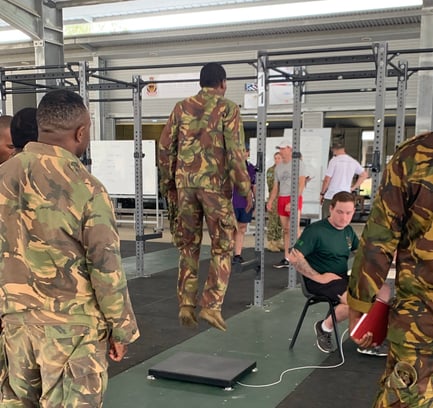This guide provides practical guidelines and examples for implementing large-scale movement screens in various environments.
Introduction
The Sparta Scan Kit is often utilized to efficiently assess large groups of individuals to obtain objective data in a single or recurring large-scale event(s). This includes, for example, pre-participation examinations, health screenings, research studies, and other events. Manual functional, orthopedic, and performance testing are often utilized in these scenarios but include inherent challenges related to subjectivity and standardization or can be time and resource-intensive. The Sparta Scan Kit provides the means to collect objective movement assessment data in an efficient and accurate manner, though there are still logistical considerations to take when assessing large quantities of individuals.

General Guidelines
The time to complete each scan varies, but the most commonly used scans range from 60-120 seconds. Because of the large variety of scan types and the ability to customize scans, contact your Customer Success or Research Representative to get the most accurate estimate of the length required for your specific scan types. In general, the following estimates can be used to represent the time of scanning plus the transition time for the next user to begin:
- Jump Scan: 2 minutes
- Balance Scan: 2 minutes
- Progressive Balance Scan: 3 minutes
- Jump & Balance Scan: 5 minutes
- Jump, Balance, Plank Scan: 7 minutes
Simply use the above times multiplied by the number of users (and divided by the number of Scan Kits) to calculate the expected amount of time required to perform a large-scale screening. These figures allow for comfortable transition time between users.
Suggestions and Best Practices:
- Utilize waves of smaller groups of individuals (15-minute increments, for example) to limit waiting times.
- Allow individuals to observe others perform the assessment while they wait to familiarize themselves with the protocols.
- Ensure individuals perform a standardized warm-up before arriving or in an “on-deck” area before assessment.
- Warm-ups or familiarization are recommended for the Jump and Isometric Mid-Thigh Pull Scans.
- Pre-loading the list of users by utilizing the user import capability to reduce the time required for creating new users is recommended.
- Alternatively, on a separate device, admins or users can create each new user individually within the Admin Application while users are in the queue.
- With minimal instruction required, the assessments can be run by an administrator familiar with the assessment protocols. No subject matter expertise is needed, and administrators may be able to run more than one Scan Kit simultaneously.
Download the Printer Friendly Balance Only Scanning Instruction PDF here.
Download the Printer Friendly Scanning Instruction PDF here.
Practical Example:
Four Sparta Scan Kits were brought in to assess 340 athletes over a four-day evaluation period, including various other assessments and tests set up in stations.
The staff (2 administrators) were allotted 4 hours per day and utilized 4 Sparta Scan Kits, each running two systems simultaneously. The staff utilized a trickle approach where athletes would visit their station in waves of 10-15 athletes spaced out by 15-20 minutes.
Athletes would arrive at the Scan Kit station previously warmed up and perform a combination scan recipe of Jump, Balance, Plank.
As four athletes scanned, the remaining athletes would watch the assessment, helping to familiarize them with the procedures and improve efficiency. Each scan took roughly 5-7 minutes to complete, allowing the group to work through upwards of 10 athletes in 15 minutes.
Calculating estimated time:
- 340 Athletes
- 7 minutes per assessment (Jump, Balance, Plank)
- 4 Sparta Scan Kits
340 x 7min / 4 = 9 hours 55 minutes total
Resources Required:
- 4 Scan Kits
- 2 Test Administrators
- ~ 10 Hours Total
Utilizing the protocol above, the assessments took a total of only 10 hours to complete while 16 hours were allotted (4 hours/day for 4 days), allowing for plenty of time for discussions and transitions between groups.
Additional Tips
- If multiple scan types are being performed, it is possible for your Customer Success Representative to request “combination scan recipes” to combine the multiple scan types into a single flow. This may require some additional lead time to enable, so it is best to contact us prior to the event.
- Remember additional time requirements based on the event expectations, environment, or demographics. For example,
- Are you planning to discuss the results with each user?
- Will your population be able to transition quickly?
- Where is the Scan Kit best fit if other assessments are being conducted?
- The Scan Kit supports the ability to be utilized in offline events (i.e., internet access is unavailable), but some additional considerations need to be made for user management.
- After an event, if you notice that duplicate user profiles have been created, it is possible to merge these duplicates by following the instructions in the linked article.
- Users can be invited to the Movement Health Platform to view their scan results; results can also be generated into PDFs and emailed or printed; with our integration capabilities, results can be automatically transferred to other systems.
Key Takeaways
- Plan Ahead: Be sure to proactively consider the event logistics, ideal scans, and resources required. For example, importing users prior to the event will drastically improve efficiency.
- Allow for Transition Time: Though an assessment itself may take only 60 seconds, some time is required for transitioning from one user to another.
- Minimal Training Required: With some minimal familiarization and utilizing the PDF resources, most anyone can be trained to administer the scans. This allows you to reserve more highly trained subject matter experts for interpretation or more resource-intensive screenings.
